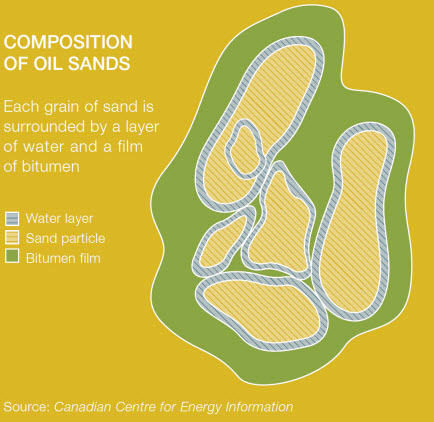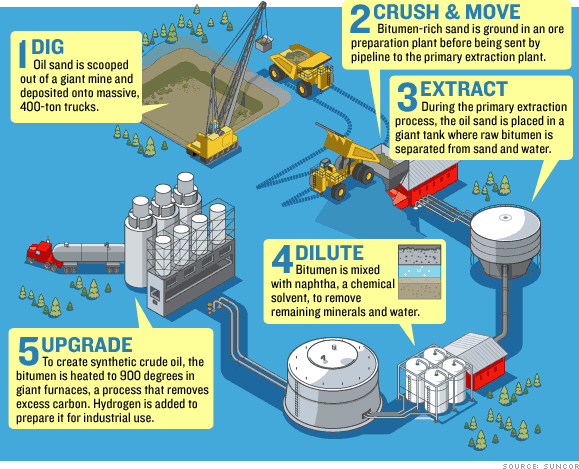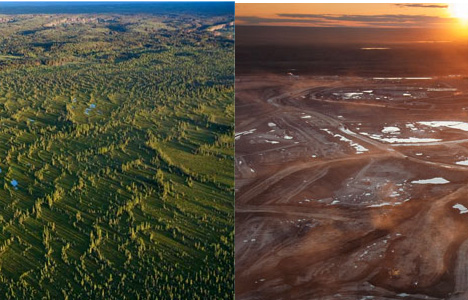What is oil sands mining?
 Crude oil deposits lie beneath the earth among layers of rock, water, and sand in the form of bitumen, a heavy, viscous type of crude oil that mixes with the geological strata like cold molasses. Mining these oil sands deposits takes place in the Athabasca region of northern Alberta, Canada, and in certain regions of Venezuela.
Crude oil deposits lie beneath the earth among layers of rock, water, and sand in the form of bitumen, a heavy, viscous type of crude oil that mixes with the geological strata like cold molasses. Mining these oil sands deposits takes place in the Athabasca region of northern Alberta, Canada, and in certain regions of Venezuela.
As a non-traditional type of crude deposit, oil sands mining remained a costly resource to extract and refine. However, oil sands mining now brings big profits to petroleum industries. Standard crude deposits continue to shrink, while barrels of crude and gallons of gas grow more expensive, driving Big Oil’s destructive harvest.
Mining companies extract bitumen through two standard, destructive methods.
Strip Mining – Traditional operations clear-cut trees and brush, and then strip top soil and clay to access the layers of oil sand beneath. The process involves massive trucks and and earth movers to extract 1 to 20% bitumen by total volume. Once filtered, the upgraded crude goes directly to refineries where it becomes manufactured in to gas, jet fuel, and other synthetics.
In Situ – Hailed originally as a newer, cheaper alternative to standard strip mining techniques, in situ forces pressurized steam into layers of bituminous sand, buried too deeply below the surface to harvest with trucks and earth movers. Pressurized steam separates the sludgy bitumen from surrounding sand and clay, pumping the thick muck to the surface, to be filtered, upgraded, and sent to refineries. Despite its acceptance as a cost-effective alternative to strip mining, in situ processes do tremendous environmental damage.
Mining’s “quick fix” to environmental restoration amounts to little more than greenwashing.
Psy Org indicated in March that David Shindler, and his colleagues at the University of Alberta had reported disturbing news regarding the long term environmental impact of oil sands mining in Canada.
While Canadian mining industry hopes to assuage public concerns by planting dry, upland trees and similar plant species destroyed through mining, Shindler calls it “greenwashing.” A simple approach to restoring a sophisticated ecology may sound like corporate responsibility, but its net effect will vastly increase carbon emissions indefinitely.
Unfortunately, 65% of Alberta’s proposed oil sands mining region contains peatlands, whose expansive, nonrenewable bogs serve as natural carbon sinks, preventing greenhouse gasses from escaping into our atmosphere.
Oil/tar sands mining in the expanded region under consideration, will destroy wildlife habitats, and permanently lay waste to the landscape’s ability to sequester carbon. An estimated 11 – 47 million metric tons of carbon gas will be released into Earth’s atmosphere as his region falls prey to oil sand mining.
Researchers who conducted this University of Alberta study, report that “the area will lose the ability to sequester carbon in the future; this [the researchers] say will add up to about 5,700-7,200 metric tons of carbon each year, which they say should be looked at as a net gain of emissions each year.”
Oil sands mining: In situ mining techniques do little to conserve Canada’s natural habitat.
In situ technology may actually cause less environmental devastation than traditional strip mining techniques for oil sand extraction, but is this too little too late? Last Friday, Gayathri Vaidyanathan of Energy & Environment Daily, shared a review of the following study published by Alberta Innovates: Thermal In Situ Water Conservation Study – A Summary Report
In 2011 alone, in situ operations in Alberta, Canada, consumed about 28 million cubic meters of water. To combat public outcry regarding huge losses to local reservoirs and the Athabasca watershed of Alberta, mining operators have begun to recycle their in situ water supply. Ironically, their recycling process may result in new environmental problems.
Alberta Innovates, an R&D corporation funded by the Alberta state government, provincial agencies, along with 9 oil and gas companies, studied in situ water recycling and its effects on waste generation and greenhouse gas emissions.
In situ extraction methods: A more efficient means of creating a wasteland.
Mining operators “drill two parallel horizontal wells, with one well used to inject pressurized steam. The steam cools to water underground, mixes with the bitumen and rises up the second well. The bitumen is removed and the water, contaminated with chemicals and ions, is recycled.”
Blowdown Evaporation
The study determined that about 90% of the water used during the in situ extraction process can recycle through existing technologies, such as blowdown evaporation. B.E. employs large machines to clean water through boiling and evaporation. Blowdown evaporation bears the fewest tradeoffs, while building on the benefits of recycling, releasing less greenhouse gas emissions and waste when compared to wholesale strip mining.
Like many other technologies that recycle water, blowdown evaporation generates liquid waste, which mining companies inject into disposal wells. In landscapes that cannot support waste-water injection as a disposal method, operators use zero-liquid discharge, or ZLD, to create solid waste as opposed to liquid. Regrettably, ZLD generates 2 – 8% more carbon emissions and tremendous amounts of solid waste.
Alberta Innovates concluded that in situ technology could improve wastewater recycling to reduce the environmental consequences of oil sands mining. However, oil sands mining methods continue to extract finite fossil fuels for profit with tragically unsustainable results. In situ processes boost air pollution, contribute to global warming, create irreparable wastelands, and build nothing for our future. Improved technology for oil sand mining will never offer us more than a legacy of destruction and better way to do the wrong thing.
What kinds of renewable fuel sources would you explore as an alternative to oil sands / oil tar mining for fossil fuels?
Related articles
- Redford fumbles the oil sands file (theglobeandmail.com)
- Alberta Innovates- Energy and Environment Solutions releases Thermal In-Situ Water Conservation Study (sys-con.com)
- The Canadian Oil Sand Mines Refused Us Access, So We Rented This Plane To See What They Were Doing (businessinsider.com)
- Imperial CEO says cleaner crude production a reality (business.financialpost.com)








